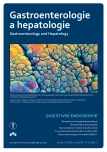Renaissance of cholangiopancreatoscopy and new ways of intraductal endoscopic therapy
Authors:
O. Urban 1–3; P. Fojtík 1; O. Mikolájek 1; U. Arnelo 4,5
Authors‘ workplace:
Centrum péče o zažívací trakt, Vítkovická nemocnice a. s., Ostrava
1; Interní klinika LF OU a FN Ostrava
2; Lékařská fakulta OU v Ostravě
3; Department of Clinical Science, Intervention and Technology (CLINTEC), Karolinska Institutet, Stockholm, Švédsko
4; Center for Digestive Diseases, Karolinska University Hospital, Stockholm, Švédsko
5
Published in:
Gastroent Hepatol 2016; 70(3): 203-207
Category:
Digestive Endoscopy: Review Article
doi:
https://doi.org/10.14735/amgh2016203
Overview
The aim of this review article is to describe the current possibilities of endoscopy for examination of the biliary tract and pancreatic duct, introduce the current terminology, and report basic endoscopic findings. Radical technological change is the transition from a system dominated by two endoscopists („dual operator“) to „single operator“ technology. The basic diagnostic indication for cholangioscopy is still indeterminate biliary tract stenosis, and the most significant therapeutic indication is lithotripsy of difficult choledocholithiasis.
Key words:
biliary tract stenosis – cholangioscopy – pancreatoscopy
The authors declare they have no potential conflicts of interest concerning drugs, products, or services used in the study.
The Editorial Board declares that the manuscript met the ICMJE „uniform requirements“ for biomedical papers.
Submitted:
19. 3. 2016
Accepted:
24. 5. 2016
Sources
1. Chen YK, Pleskow DK. SpyGlass single-operator peroral cholangiopancreatoscopy system for the diagnosis and therapy of bile-duct disorders a clinical feasibility study (with video). Gastrointest Endosc 2007; 65(6): 832–841.
2. Urban O, Arnelo U, Fojtík P et al. Cholangiopankreatikoskopie pomocí SpyGlass direct visualisation system: seznámení s metodou a první vlastní zkušenosti. Gastroent Hepatol 2013; 67(2): 124–126.
3. Husťak R, Ušák J, Kudlová D et al. Prvé skúsenosti s digitálnym Spyglass™ DS na Slovensku z gastroenterologického pracoviska Fakultnej nemocnice Trnava. Gastroent Hepatol 2015; 69(5): 418–423.
4. Moon JH, Ko BM, Choi HJ et al. Intraductal balloon-guided direct peroralcholangioscopy with an ultraslim upper endoscope (with videos). Gastrointest Endosc 2009; 70(2): 297–302. doi: 10.1016/j.gie.2008.11.019.
5. Chen YK, Parsi MA, Binmoeller KF et al. Single-operator cholangioscopy in patients requiring evaluation of bile duct disease or therapy of biliary stones (with videos). Gastrointest Endosc 2011; 74(4): 805–814. doi: 10.1016/j.gie.2011.04.016.
6. Draganov PV, Chauhan S, Wagh MS et al. Diagnostic accuracy of conventional and cholangioscopy-guided sampling of indeterminate biliary lesions at the time of ERCP: a prospective, long-term follow-up study. Gastrointest Endosc 2012; 75(2): 347–353. doi: 10.1016/j.gie.2011.09.020.
7. Tringali A, Lemmers A, Meves V et al. Intraductal biliopancreatic imaging: European Society of Gastrointestinal Endoscopy (ESGE) technology review. Endoscopy 2015; 47(8): 739–753. doi: 10.1055/s-0034-1392584.
8. Sethi A, Shah R, Itoi T et al. Defining imaging criteria for indeterminate biliary strictures utilizing video cholangioscopy: the Monaco classification. Gastrointest Endosc 2015; 81 (Suppl 5): AB 188–AB 189. doi: 10.1016/j.gie.2015.03.1939.
9. Beyna T, Neuhaus H. Role of cholangioscopy and pancreatoscopy in biliopancreatic lesions. Presented at: 18th Düsseldorf international endoscopy symposium. 11.–13. 2. 2016.
10. Costamagna G. RFA for biliopancreatic tumours. Presented at: 18th Düsseldorf international endoscopy symposium. 11.–13. 2. 2016.
11. Valente R, Urban O, Del Chiaro M et al. ERCP-directed radiofrequency ablation of ampullary adenomas: a knife-sparing alternative in patients unfit for surgery. Endoscopy 2015; 47 (Suppl 1): E515–E516. doi: 10.1055/s-0034-1392866.
12. Špičák J. Cholangioskopie. In: Špičák J, Urban O. Novinky v digestivní endoskopii. Praha: Grada Publishing 2015.
13. Arnelo U, Siiki A, Swahn F et al. Single-operator pancreatoscopy is helpful in the evaluation of suspected intraductal papillary mucinous neoplasms (IPMN). Pancreatology 2014; 14(6): 510–514. doi: 10.1016/j.pan.2014.08.007.
Labels
Paediatric gastroenterology Gastroenterology and hepatology SurgeryArticle was published in
Gastroenterology and Hepatology

2016 Issue 3
- Metamizole in perioperative treatment in children under 14 years – results of a questionnaire survey from practice
- Metamizole vs. Tramadol in Postoperative Analgesia
- The Importance of Limosilactobacillus reuteri in Administration to Diabetics with Gingivitis
- Safety and Tolerance of Metamizole in Postoperative Analgesia in Children
Most read in this issue
- Colon stenosis of unexplained etiology
- The Mutaflor® – Escherichia coli (Nissle 1917), serotype O6:K5:H1 – the best researched probiotic available
- Endoscopic management of sigmoid volvulus
- Neuroendocrine neoplasms in gastroenterologist practice
